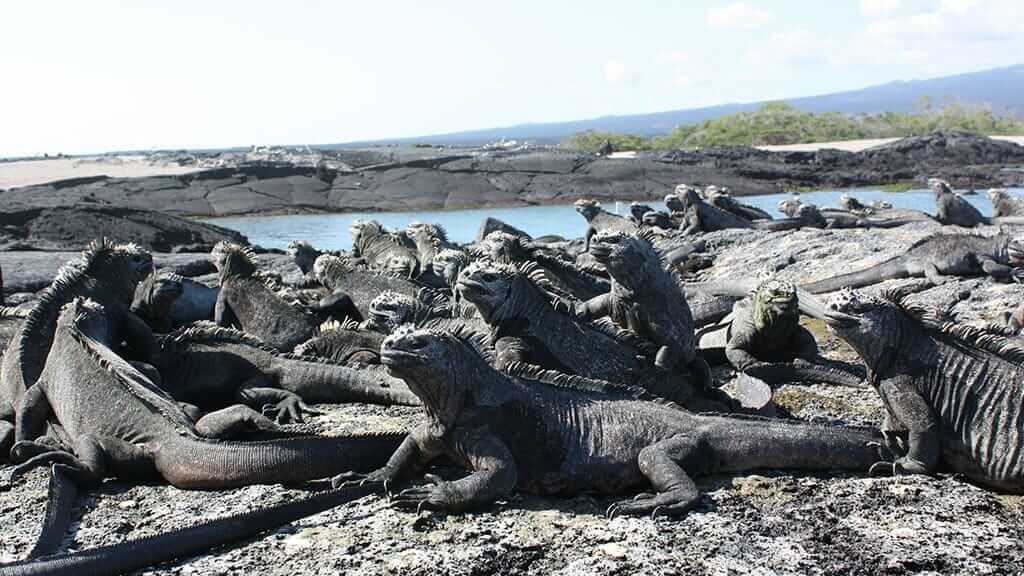Charles Darwin and Evolution are indebted to the Galapagos Islands. The archipelago itself was formed by underwater volcanoes erupting-building up layer by layer until they broke the surface.
The Galapagos Islands are home to an intriguing number of species that have adapted to their environment-changing stature and girth depending on the demands of the natural surroundings.
The sightings of different species of giant tortoises, finches, and iguanas that appear around every bend are astounding-leaving you in awe of nature’s capacity towards change and renewal.
Giant Tortoises
Giant tortoises and the Galapagos Islands go hand in hand. The enduring animal has seen pirates and whalers drive some of their kind to extinction through hunting, watched as the early settlers harvested tortoise oil to sell to the mainland for fuel, and were around when volcanoes devastated entire islands.
Through these changes-giant tortoises have adapted over generations. Dome-shaped tortoises are found in the highlands of islands like Santa Cruz and Isabela. The abundance of vegetation and water has led to shorter necks and shorter limbs. Saddle-backed tortoises are native to lower, drier zones in the islands-long necks and limbs help to reach cactus plants and vegetation above the brush.
Other adaptations are brought to light on Isabela Island, where five different species of giant tortoises have evolved around each of the island’s volcanoes and their lava flows.
The native species of some islands, such as Santa Fe, were rendered extinct by pirates, whalers, and in some cases man-made fires set by hunting parties.
The Galapagos National Park and the Charles Darwin Foundation are working to repopulate these islands. Santa Fe is currently in the midst of a multi-year program that releases fledgling tortoises into the wild in an effort to constantly increase the population and its chances of survival.
There are reserves where tortoises roam free within spacious borders and breeding centers where tortoises are raised from hatchling to juvenile-before being released into open spaces. Santa Cruz, San Cristobal, and Isabela have centers and private reserves where different kinds of tortoises amble about along trails, beside ponds, and under the shade of the nearby forests.
Finches
The remarkable adaptations of the Galapagos finch astounded Charles Darwin and have captured the imagination of naturalists, scientists, and nature enthusiasts ever since.
Today there are upwards of 13 finches found in the trees, forests, mangroves, and tundra of the islands. Sites like Los Gemelos on Santa Cruz, two collapsed magma chambers where forests have taken over the landscape, host a variety of finch species.
Where you can spot each of the species is also why they separated from the rest of the finches. Ground-dwelling, seed-eaters are found in forests, as are a handful of tree-dwelling insect eaters. Other more arid climates like Santa Fe island are home to finches that feed on cactus plants.
Beaks of the different cousins in the finch family are well-suited to the task at hand. Cactus finches have longer, larger beaks compared to those of ground finches. Others, like the warbler finch, have thinner and pointier beaks than both the ground and cactus finches.
Iguanas
Iguanas in the Galapagos are an intriguing part of the story of how animals in the islands adapted to their environment. Different islands have their own species, like the Santa Fe yellow iguana.
The islands are also home to the endemic marine iguana, the only one of its kind on the face of the Earth. The agile swimmer feeds off of algae and plankton beneath the water’s edge and is often seen when snorkeling and diving around the archipelago.
There are colonies on many of the islands-including Santa Cruz, San Cristobal, Isabela, and North Seymour. Each of these islands has marine iguanas that differ in stature to those of the others. Isabela is known for the largest marine iguanas, while Genovesa island has the smallest and darkest members of the species.
When the reptile is landlocked it is cumbersome, but its fast swimming speeds make outrunning predators an exercise in persistence. Marine iguanas change colors during mating season-donning bright orange, red, green, blue, and brown shades to impress a mate.
The Galapagos Islands are ripe with opportunities to see the incredible wildlife that highlights nature’s ability to adapt and change. The different kinds of species that inhabit the variety of landscapes both above and below the sea are astounding in number and diversity. This incredible eco-system is the backbone of the islands and needs to be experienced to be fully understood.
Note: All information is intended as a general guide of what you might be able to see or do on this island. In reality, wildlife sightings are by nature unpredictable, and activities may be subject to change by your guide or the National Park Authority.
For more information about your options for land-based and cruise trips through the Galapagos Islands, contact a member of our team using our toll-free numbers or the contact form on this site.




